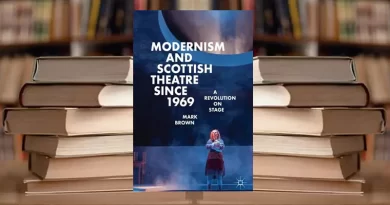“Dark Star: A Biography of Vivien Leigh”
Dark Star: A Biography of Vivien Leigh by Alan Strachan
Bloomsbury Publishing PLC
Reviewed by Jeremy Malies
1 December 2018
Alan Strachan is a practical man of the theatre, indeed a first-rate director, and I don’t think I’ve ever been so subtly educated in general stage matters while also learning about somebody in a theatre biography.
I tried to go through this book chronologically but it’s so tempting to race towards what you know will be fascinating elements with the broadest possible canvas of people. The element that intrigued me was the scrambling for the most sought-after leading role in cinema history. (If Leigh’s shade is pleased by this biography – and I think it would be – she might be gratified that I could hardly wait to rewatch Gone with the Wind and A Streetcar Named Desire armed with what I had learned.) There is a wonderful anecdote culled from the autobiography of Observer film critic C.A. Lejeune recalling a boating trip when casting announcements for Gone with the Wind were imminent. “She drew herself up on the rainswept deck … pulled a coat around her shoulders and stunned us all with the sibylline utterance: ‘Larry won’t play Rhett but I shall play Scarlett O’Hara. Wait and see.’”
Strachan’s pedigree means that when the terms of reference are broad, you accept his verdicts unquestioningly. He also lazers in on the specific and is deft in quoting personal judgements from a weight of letters and diaries that might have overwhelmed other biographers. I think particularly of David Niven’s concise, aphoristic remark: “The most beautiful woman I ever saw outside an art gallery.”
Dead of tuberculosis with complications from a history of heavy drinking at the age of 53 in 1967, Leigh is rightly remembered for the obvious accolades of two Oscars (Gone with the Wind and Streetcar) but also for an academic intelligence and respect for her roles as written that saw her take on everybody from movie producers to the Lord Chamberlain, always championing what her literary instincts told her were a writer’s intentions. This is a woman whose favourite author was Montaigne and cerebral roles were always welcomed. At the age of 11 in 1924 she had sat through Hamlet at Stratford spellbound (Arthur Phillips as Hamlet, Ethel Carrington as Ophelia). Thirteen years later she would play Ophelia opposite her husband Laurence Olivier at Elsinore, a review by J.C. Trewin in Plays and Players (the precursor of this magazine) including: “The mad scenes endure. The tragedy was there and unprettified.”
Without becoming submerged in detail, Strachan outlines how Leigh could move effortlessly from celluloid to stage, showing an instinctive grasp of what directors and audiences required whether that be a facial expression in a cinema close-up or a sightline out to the cheaper seats of the Old Vic. With her intuitive film acting ability, you wonder what she might have achieved behind the camera. There was of course a solid training at RADA where she had been a model student. With all these gifts, she was sufficiently modest to welcome clear strong direction. The biography is also revealing on how Leigh and Olivier functioned in joint theatre projects, notably in London in 1947 in Jean Anouilh’s adaptation of Antigone (Olivier as producer and Chorus, Leigh as the title character) with Leigh making suggestions at levels ranging from set design to dialogue tweaks.
The treatment of Leigh’s manic depression (probably a variant of bipolar disorder in our terminology) is gruelling. Perhaps I’m a prude but I have little interest in exactly what stage couples do in the bedroom unless it informs the whole dynamic of how they behave in public and what they achieve as artists. There is a little too much sex here for my liking though Olivier’s early verdict on the woman who would become his wife, “She could pass for a Javanese tart” is delicious if off-the-scale non-PC for the modern reader.
I could not find a single cliched phrase anywhere; Strachan is a fine stylist and the only glitch I noted (a shocker from such an urbane writer is Dorian Grey for Dorian Gray). Strachan is always objective and even sceptical about his sources, particularly when telling us that Sir Laurence’s own recollections in his (1982 – seven years before his death) Confessions of an Actor are intrinsically unsound or contradict other reliable records. Leigh’s contemporaries recall that when riled or confronted by somebody who she felt was behaving badly she could be acerbic, but in everyday situations and when dealing with underlings her manners were exquisite. There were of course the mood swings at a clinical level (the so-called “episodes”) but these dual-personality incidents often manifested as self-hatred.
As David O. Selznick was looking for his Scarlett, he said, “The girl I select must be possessed of the devil and charged with electricity.” As an artist Vivien Leigh had range, depth, quick wits and integrity. As a human being she floated in a state of euphoria; meteoric with all the ephemeral qualities bound up in that term. This is a fine insightful biography that captures the vigour and life-enhancing qualities of its subject, her acting husband and their high-achieving circle of friends.
ISBN: 9780755600571









